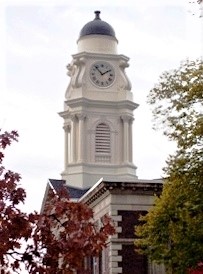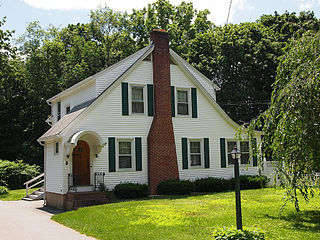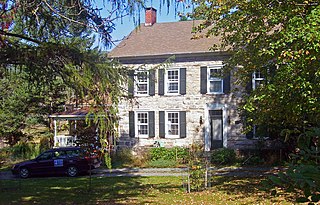
Cohoes is an incorporated city located in the northeast corner of Albany County in the U.S. state of New York. It is called the "Spindle City" because of the importance of textile manufacturing to its growth in the 19th century. The city's factories processed cotton from the Deep South.

Cold Spring is a village in the town of Philipstown in Putnam County, New York, United States. The population was 1,986 at the 2020 census. It borders the smaller village of Nelsonville and the hamlets of Garrison and North Highlands. The central area of the village is on the National Register of Historic Places as the Cold Spring Historic District due to its many well-preserved 19th-century buildings, constructed to accommodate workers at the nearby West Point Foundry. The town is the birthplace of General Gouverneur K. Warren, who was an important figure in the Union Army during the Civil War. The village, located in the Hudson Highlands, sits at the deepest point of the Hudson River, directly across from West Point. Cold Spring serves as a weekend getaway for many residents of New York City.

Irvington, sometimes known as Irvington-on-Hudson, is a suburban village in the town of Greenburgh in Westchester County, New York, United States. It is located on the eastern bank of the Hudson River, 20 miles (32 km) north of midtown Manhattan in New York City, and is served by a station stop on the Metro-North Hudson Line. To the north of Irvington is the village of Tarrytown, to the south the village of Dobbs Ferry, and to the east unincorporated parts of Greenburgh, including East Irvington. Irvington includes within its boundaries the community of Ardsley-on-Hudson, which has its own ZIP code and Metro-North station, but which should not be confused with the nearby village of Ardsley.

Brandywine Creek is a tributary of the Christina River in southeastern Pennsylvania and northern Delaware in the United States. The Lower Brandywine is 20.4 miles (32.8 km) long and is a designated Pennsylvania Scenic River with several tributary streams. The East Branch and West Branch of the creek originate within 2 miles (3 km) of each other on the slopes of Welsh Mountain in Honey Brook Township, Pennsylvania, about 20 miles (32 km) northwest of their confluence.

List of the National Register of Historic Places listings in Ulster County, New York

Mount Gulian is a reconstructed 18th century Dutch manor house on the Hudson River in the town of Fishkill, New York, United States of America. The original house served as the headquarters of Major General Friedrich Wilhelm von Steuben during the American Revolutionary War and was the place where the Society of the Cincinnati was founded. The site is registered as a National Historic Landmark.

Shockoe Bottom historically known as Shockoe Valley, is an area in Richmond, Virginia, just east of downtown, along the James River. Located between Shockoe Hill and Church Hill, Shockoe Bottom contains much of the land included in Colonel William Mayo's 1737 plan of Richmond, making it one of the city's oldest neighborhoods.

Dutch Colonial is a style of domestic architecture, primarily characterized by gambrel roofs having curved eaves along the length of the house. Modern versions built in the early 20th century are more accurately referred to as "Dutch Colonial Revival", a subtype of the Colonial Revival style.

The Clinton House is an 18th-century Georgian stone building in the city of Poughkeepsie, Dutchess County, New York, United States. It is a New York State Historic Site and has been listed in the National Register of Historic Places as a historic place of local significance since 1982. The house was named for George Clinton, who served as the first Governor of New York and fourth Vice-President of the United States. He was believed to have lived there after the American Revolutionary War, but it is now known that it was never his residence.

"Fort Decker" is a stone house built in 1793 from the remains of the fort of that name. It is located on West Main Street in Port Jervis, New York, the oldest building in that city, which it predates by several decades.

Riverby was the estate of the American naturalist John Burroughs (1837–1921), who wrote and created a genre of naturalist essays. It is located above the west bank of the Hudson River, in the town of West Park, in Ulster County, New York. Burroughs built the main house and a separate study, where he did much of his most influential writing. The property was designated a National Historic Landmark in 1968. It is private property, still partially held by the Burroughs family, and is not open to the public.

The Senate House State Historic Site is located on Fair Street in Kingston, New York, United States. During the Revolutionary War, New York's First Constitutional Convention met there and on April 20, 1777, adopted the first New York State Constitution. After one month, the Senate fled the British troops who were advancing from Manhattan. The Senate House and much of Kingston was burned in retribution. It has served as a museum from the late 19th century. Currently it is owned and operated by the New York State Office of Parks, Recreation and Historic Preservation.

The Johannes Jansen House, also known as Johannes Jansen House and Dutch Barn, is located along Decker Road at the foot of the Shawangunk Ridge in the western section of the Town of Shawangunk, in Ulster County, New York, United States. It was started by Jansen, who had settled the area along with his brother Thomas, whose own house is a mile (1.6 km) to the southeast, in 1750. His son finished it in the newer Federal style 53 years later. The property also boasts a Dutch barn.

The Binghamton was a ferryboat that transported passengers across the Hudson River between Manhattan and Hoboken from 1905 to 1967. Moored in 1971 at Edgewater, Bergen County, New Jersey, United States, the ship was operated as a floating restaurant from 1975 to 2007. In 2017, following ten years of damage that effectively rendered the boat unrestorable, the ferry was dismantled. No structural components were salvaged.

Quackenbush House is a historic building in Albany, New York. It is a house with a double-pitched gable roof that was built in about 1736. It was listed on the National Register of Historic Places in 1972.

The Benner House is located on Mill Street in the village of Rhinebeck, New York, United States, just off U.S. Route 9. It was built by a German immigrant, Johannes Benner, in the 1730s. It is the oldest house in the Village of Rhinebeck.

The Neher–Elseffer House is located on U.S. Route 9 a short distance north of its intersection with New York State Route 9G in Rhinebeck, New York, United States. It is a frame house built in 1746, one of the rare pre-Revolutionary frame houses in the Rhinebeck area. Its current appearance reflects renovations made circa 1800, and the interior was altered in the 1830s.

Graham-Brush Log House is a historic home located in the Town of Pine Plains, Dutchess County, New York. It was built in about 1776 and is a two-room log structure with a wood frame lean-to on its rear elevation. It measures roughly 39 feet long and 18 feet wide. It is one and one half stories with a gable roof; the lean-to addition is one story. The Brush house was acquired in 1997-1998 by the local historical society, the Little Nine Partners Historical Society. In 1998 it was damaged by an arson fire.

New Paltz station is a former train station in the village of New Paltz in Ulster County, New York. The building was the first of two railroad stations constructed in the town of New Paltz, and it is the only former Wallkill Valley Railroad station standing at its original location.
Idlewild, also known as the Downman House, was a historic home located at Fredericksburg, Virginia. It was built in 1859; a fire in April 2003 destroyed most of the interior and collapsed the roof. It was a 2+1⁄2-story, Gothic Revival-style brick dwelling with an English basement and an irregular "T" shape with a center passage plan. The house was topped by a steep slate gable roof. Also on the property at present are three contributing brick dependencies and a contributing pet cemetery. During the American Civil War, Idlewild became a prominent landmark on May 4, 1863, during battle action related to the Chancellorsville campaign. On that evening Confederate General Robert E. Lee used the house as his headquarters, after being initially occupied that day by Federal troops of the Union Sixth Corps.



















